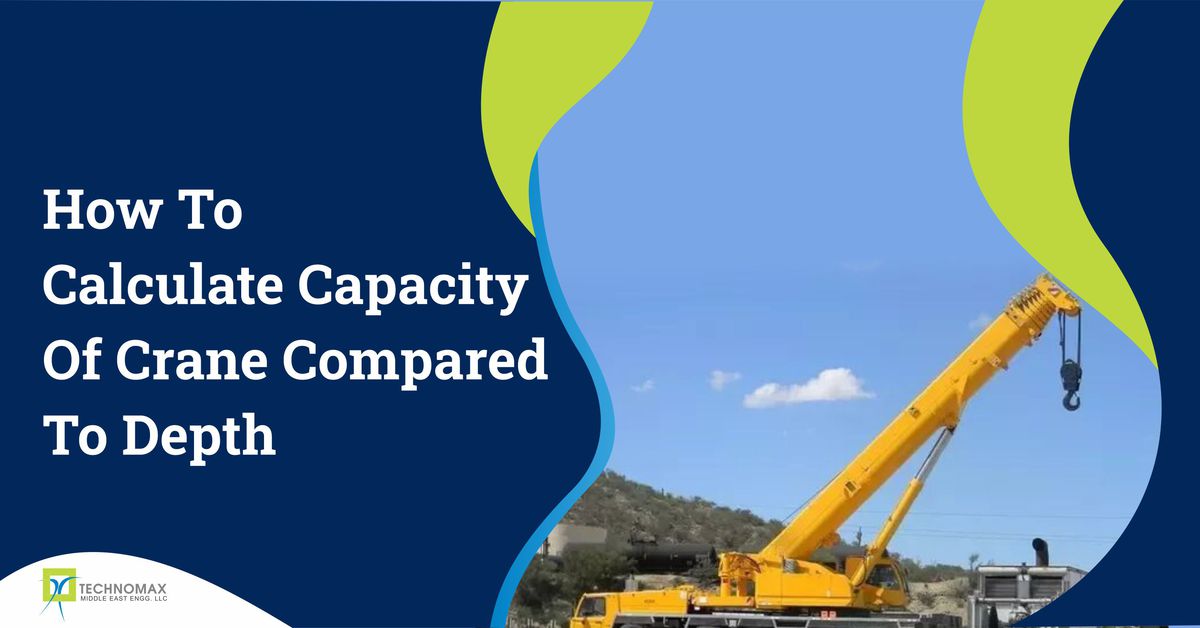
Knowing the crane capacity is critical for safely operating a crane without lowering the load or damaging the machine. This number must be recalculated each time a crane is used since it varies depending on the location of the hoist and the lift radius, among other factors.
How Much Load Can a Crane Lift?
Have you ever watched a crane hoist an enormous load and wondered just how much weight it’s lifting? With its slender, extended arm, it’s hard to believe these machines are capable of handling such heavy materials.
Operating and understanding cranes requires specialized training and knowledge, including knowing their lifting limits. Although cranes are powerful machines, they aren’t invincible. Every type of crane has a maximum weight it can safely handle. For crane operators, understanding these weight limits is essential to ensuring not only their own safety but also the safety of everyone on the job site.
Crane load capacity is one of the essential considerations in any construction project. The crane load capacity is determined to ensure a healthy working environment and enable the project to move forward smoothly. For the load chart, you will need to locate the Crane Capacity index. When considering crane installation, one needs to also look for the capacity of the crane to avoid mishaps and risks related to crane load testing.
Physics of a Crane
A crane is controlled from an outrigger foundation, a movable and rotating platform that can be several metres high. The boom arm stretches upward and outward at a set angle for the entirety of its length, with an apparatus at the end that raises and moves the load. There are no horizontal forces since the load (mass times gravity g, or 9.8 m/s2) is lifted vertically (windy days play havoc for crane operators).
Instead, when the crane's upward force precisely balances the weight of the load, a tension T (force per unit length) is preserved in the rope. The load moves upward when the motor drives T above this point, assuming the cable is strong enough to withstand the power.
Also Read:
- Electric Overhead Travelling Cranes-Applications and Types
- Erection and Commissioning of EOT Cranes
- 7 Different Types of Industrial Cranes
The Geometry of a Crane
The crane boom, the field, and the vertical cable form a right triangle when viewed from one side. The boom arm is the hypotenuse, the distance r from the outrigger base to the load is the long arm of the triangle, and the vertical height h of the boom "tip" above the ground is the short arm of the hypotenuse. For calculating lifting power, the effective radius r must account for the outrigger base and is thus slightly shortened; that is, it does not begin at the motor, where the tip of this de facto right triangle lies.
Key Factors Influencing Crane Lifting Capacity
Determining how much weight a crane can safely lift is not a matter of trial and error. Several critical factors determine a crane’s maximum load, with two of the most important being its operating range and the information provided in the load chart.
- Operating Range
The operating range defines how far the crane can move a load safely, both vertically and horizontally. This range plays a vital role in understanding how the crane functions under different conditions. - Load Chart: Every crane is supplied with a manufacturer’s manual and that outlines safety features, key components, and the crane’s weight limits. The load chart found in this manual specifies the maximum loads the crane can handle under various conditions. These limits are determined by factors such as the load radius, environmental conditions, and the crane’s specific design.
Factors Affecting the Capacity of Crane Installation
Before considering crane installation, it is important to determine the factors that affect the crane’s capacity.
- Unbalanced Rope Reeving and Boom Twist: When the main hoist line is reeved to one side of the boom tip, unbalanced rope reeving occurs. The crane's rated capacity is reduced as a result of this situation, as the boom twists. Only when the boom tip is symmetrically rigged can full chart ratings be applied. The boom twist is reduced in single-line reeving when the hoist line runs along with the centre sheave or the sheave beside the boom's centerline. The boom twist will be reduced on multi-part reeved systems if the line sections are equally distributed on either side of the boom centerline.
- Ground Surface Stability and Load Bearing: The ground surface must have sufficient stability and bearing power to accommodate all of the crane's loads. When lifting near houses, mainly those new and have uncompacted backfill, trenches, or areas where water mains, sewer pipes, or steam lines are buried, extreme caution should be used. Depending on the working conditions and the quadrant(s) of operation, a crane installation exerts varying pressures on its load-bearing surfaces. The machine's total weight is spread over the entire area of the drive tracks or all outrigger supports, resulting in the minimum bearing pressure.
- Effects of Side Loading on Crane Capacity: Only openly suspended loads and loads picked up directly under the boom tip are subject to the load chart ratings. Sideloading happens when the load is on either side of the boom tip, reducing the crane's power. One of the most common causes of boom failure is side loading, which usually happens without notice. When a load is dragged or pulled sideways, when the load begins swinging rapidly, when the crane installation is not level or exposed to high wind speeds, side loading may occur.
- Wind Speed and Its Impact on Crane Operation: High wind speeds reduce a mobile crane's capacity by increasing side loading on the boom and load radius and reducing tipping (both forward and backward) capacity. Furthermore, lifting in windy conditions makes it more difficult to control the load.
- Importance of Proper Crane Leveling: The crane installation load chart scores assume that it is completely level in all directions. Sideloading of the boom occurs when a tower crane capacity is not level, lowering the rated power. Initial leveling should be done with the crane's target level; however, a carpenter's level should be used for vital lifts.
What is Crane Load Chart?
A crane load chart is a comprehensive reference guide that provides vital information about the crane's capacity based on various factors. Essentially, it is a graphical representation or table outlining the relationship between a crane's operational parameters and the loads it can safely lift under different conditions.
In the world of construction and heavy lifting, precision and safety are paramount. One tool that plays a crucial role in ensuring both is the crane load chart. This document, often overlooked by the untrained eye, holds the key to understanding the lifting capabilities and limitations of a crane. In this blog post, we delve into the intricacies of the crane load chart, shedding light on its importance and how it serves as an indispensable guide in lifting operations.
Key Components of a Crane Load Chart:
- Boom Length: The crane load chart typically displays different sections of the boom and their corresponding capacities. The length of the boom significantly influences the crane's lifting capacity.
- Radius: The distance from the crane's center to the load, known as the radius, is a critical factor. Load capacities vary based on the radius, and the load chart accounts for these variations.
- Configuration: Different crane configurations, such as retracted or extended outriggers, impact the crane's stability and lifting capacity. The load chart provides information on how these configurations affect performance.
- Wind Speed: External factors like wind speed can significantly impact a crane's stability. Load charts often include guidelines for safe lifting in various wind conditions.
Calculating the Crane Capacity Using the Crane Load Chart
Finding the crane's precise lifting capacity is not difficult; in fact, it is straightforward.
- Crane Load Chart- Each crane installation comes with a load chart detailing the crane's capabilities, including its features and how its lift ability varies depending on distance and angle. Failure to review a crane capacity chart before renting or hiring a crane for a particular job could leave you with too much or too little power for your job, similar to the adage "if you don't prepare, you plan to fail." The crane map must be consulted before a crane is leased, shipped, hired, or purchased. All must interpret a crane map, from the crane operator to the work managers and even the salesmen. The pointers to keep in mind on how to read the load chart.
- The measurements of the crane are depicted in the chart. It contains information about how to operate with the outriggers extended and transport weight and steering measurements. Since the lifting capacity varies depending on whether the outriggers are extended, knowing this information is particularly important if the crane operates in a confined space. The transport weight decides the trailer to use, load the crane onto the trailer, the path to take, and what permits are required to get it to the job site.
- The crane installation unique lift is indicated by the legend on the chart. The feet on the left axis indicate the radius (or distance) from the center pin to the center of the load when graphing the lift. Often determine the crane's maximum capacity by the shortest lift, generally over the crane's back with the outriggers fully extended.
- Lift charts are often used in range diagrams to show how much boom length is needed to lift loads at any distance or height. When using a luffing or fixed crane jib, the lift angle refers to the highest lift. The crane's pick and carry is referred to as a "crane in motion." The load map depicts the total weight picked up while stationary at a 360-degree angle. Both the rolling load at a zero-degree angle and the total weight when moving can be supported by the total weight.
- You will need to know the machine's geometry to get an accurate crane installation load estimate. The boom, hoist, and field, which form a triangle, are all elements that should be calculated. You can get an accurate crane load estimate by measuring the dimensions of this triangle.
(r)(hC)/100 is the standard formula for calculating maximum crane power.
Where
R- radius between the load and the ground
hC = Capacity multiplied by lifting height
Importance of the Crane Load Chart
Safety: The primary purpose of the load chart is to ensure the safe operation of the crane. Operators can determine the maximum loads that can be lifted under specific conditions by referencing the chart, thereby minimizing the risk of accidents.
Efficiency: Understanding the crane's load chart allows operators to optimize lifting operations. Understanding the crane's load chart helps operators choose the right crane for a job and ensures efficient and safe lifts within the crane's working limits.
Compliance: Compliance with load chart guidelines is essential for meeting industry regulations and standards. Adhering to these guidelines not only ensures safety but also avoids potential legal repercussions.
Training: The load chart serves as a valuable tool in operator training. Familiarity with the chart is crucial for operators to make informed decisions during lifting operations.
The secret to a secure and efficient construction job is to understand your equipment. One of the most important things that need to be considered is the crane’s capacity and how it can be calculated to ensure efficient working of the crane installation. And if you are planning a crane installation in UAE, then these pointers might come in handy.
Learn More About Our Services

Recent Blogs

Get Started Now!
It takes less than a minute of your time. Or you may simply call +971 2 555 1 783






